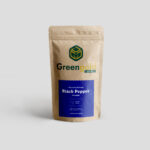Cardamom, known as the “Queen of Spices,” is a high-value crop widely cultivated in tropical regions. However, one of the major pests that affects cardamom productivity is thrips. If left uncontrolled, thrips can severely damage cardamom plants, affecting both the quality and quantity of the yield.
In this blog, we’ll cover how to identify thrips, understand the damage they cause, and learn about effective control and management practices.
What Are Thrips?
Thrips are tiny, slender insects with fringed wings. The most common species attacking cardamom is Sciothrips cardamomi. These pests are barely visible to the naked eye, measuring around 1-1.5 mm in length, but they can cause significant damage.
How Do Thrips Damage Cardamom?
Thrips primarily feed on the tender parts of the cardamom plant—such as leaves, flowers, and young capsules—by sucking the cell sap. Their feeding results in:
- Silvery or bronze streaks on leaves
- Curling and drying of leaf margins
- Flower and bud drop
- Scarring of the capsules, reducing their market value
- Stunted plant growth in severe cases
When Are Thrips Most Active?
Thrips population tends to increase during dry seasons or periods of low humidity. Their activity is most noticeable during the post-monsoon period, which is the flowering and fruiting stage of cardamom—making it a critical time for farmers to stay alert.
Life Cycle of Thrips
Understanding their life cycle is essential for planning control measures:
- Egg Stage: Laid inside plant tissue
- Nymph Stage: Actively feed and cause the most damage
- Pupal Stage: Occurs in the soil or leaf litter
- Adult Stage: Winged adults disperse to new plants
The entire cycle completes within 15-20 days under favorable conditions, leading to rapid population growth.
Symptoms of Thrips Infestation in Cardamom
✅ Silvery patches or streaks on leaves
✅ Leaf curling and drying
✅ Flower buds failing to bloom
✅ Scarring and deformed capsules
✅ Reduced seed set and yield
Management and Control of Thrips in Cardamom
1. Cultural Practices
- Regular field inspection to detect early infestations
- Shade regulation to maintain humidity and reduce thrips population
- Removal of infested plant parts and fallen leaves
- Maintain proper plant spacing for air circulation
2. Biological Control
- Predators like lacewings and ladybird beetles naturally reduce thrips population
- Entomopathogenic fungi such as Beauveria bassiana can be applied as biopesticides
3. Chemical Control (Use as the Last Resort)
- Spray Neem oil (2-3%) or fish oil rosin soap for mild infestations
- Use systemic insecticides like Imidacloprid or Fipronil under the guidance of agricultural experts
- Follow recommended waiting periods to ensure residue-free cardamom
Integrated Pest Management (IPM) Approach
For sustainable cardamom farming, it’s best to combine all the above methods:
✅ Regular monitoring
✅ Natural predators preservation
✅ Minimum use of chemicals
✅ Environmental-friendly biopesticides
Conclusion
Thrips might be tiny, but their impact on cardamom farming is huge if left unchecked. Early detection, regular monitoring, and adopting an integrated management strategy are crucial to protect your cardamom crop and ensure a good harvest.
Have you faced thrips problems in your cardamom plantation? Share your experience or ask questions!



